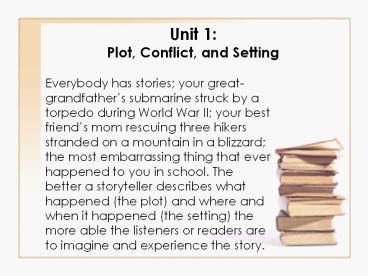Unit 1: Plot, Conflict, and Setting - PowerPoint PPT Presentation
1 / 18
Title: Unit 1: Plot, Conflict, and Setting
1
Unit 1 Plot, Conflict, and Setting
- Everybody has stories your great- grandfathers
submarine struck by a torpedo during World War
II your best friends mom rescuing three hikers
stranded on a mountain in a blizzard the most
embarrassing thing that ever happened to you in
school. The better a storyteller describes what
happened (the plot) and where and when it
happened (the setting) the more able the
listeners or readers are to imagine and
experience the story.
2
Unit 1 Plot, Conflict, and Setting literature
books page 24.
- Read the first two paragraphs on page 24.
3
Settingliterature books page 24.
- Setting Is the time and place of the action. The
time can be the past, present, or future. It can
also be a particular season or time of day. The
place can be anywhere in the world or in your
imagination.
4
Settingliterature books page 24.
- Examples
- A rainy day on the planet Venus
- A tropical island in the present day
- A city park in the year 2086
- A palace in England in 1547
5
SettingHow it can influence literature
- Create a sense of reality Vivid details can make
a setting seem very real to us, helping us
imagine how people live, what they eat, how they
dress, and where they work. - Create an atmosphere Writers often use setting
to create an atmosphere, or mood creepy,
peaceful, joyous, threatening. - Provide Conflict In many stories the characters
are in an external conflict with the setting. You
see this kind of conflict often in movies, such
as when a character is lost in a blizzard or
struggles to survive on a deserted island. If the
character is triumphant, the story has a happy
resolution. If the setting is more powerful then
the character, the storys resolution can be
tragic.
6
Conflictliterature books page 24.
- Conflict A conflict is the struggle that a
character faces in a story. The struggle can be
between characters or between a character and a
force of nature, such as the weather. A conflict
can also be within a character, as he or she
struggles with difficult choices.
7
Conflictliterature books page 24.
- External Conflict
- Character Vs. Character The main character in
any conflict is called the protagonist. A
character who opposes the main character is
called the antagonist. - Example A girl is made fun of by her friends.
8
Conflictliterature books page 24.
- External Conflict
- Character Vs. Nature The main character faces a
struggle with nature. - Example A family seeks shelter from a storm.
9
Conflictliterature books page 24.
- Internal Conflict
- Character Vs. Self The main character faces a
struggle within him or herself. - Example A boy must decide between telling the
truth and lying to protect his friends feelings.
10
Setting and Conflictliterature books page 25.
- Read model 1 and answer the close read questions.
- Read model 2 and answer the close read questions.
11
Plotliterature books page 26.
- Plot The series of events that make up the story
- Read the first two paragraphs on page 26.
12
Plotliterature books page 26.
- Exposition introduces the setting and the
characters and sets up or hints at the conflict - Answers the following questions
- Who are the characters?
- When and where does the story take place?
- What is the conflict?
13
Plotliterature books page 26.
- Rising Action shows how the conflict becomes
more difficult and builds suspense - Answers the following questions
- What events happen as a result of the conflict?
- What new problems or obstacles do the characters
face? - If the storys conflict could be resolved easily,
there wouldn't be much of a story. Thats why
writers introduce complications to the plot. The
rising action consists of additional problems
that prevent the main character from resolving
the conflict. The rising action helps create
suspense.
14
Plotliterature books page 26.
- Climax is the most exciting part and turning
point, it makes the outcome of the conflict clear
- Answers the following questions
- What is the most exciting part of the story, when
the conflict is most intense? - Climax is the point of greatest interest in a
story or play. The climax usually occurs toward
the end of a story. At the climax, the conflict
is resolved and the outcome of the plot usually
becomes clear.
15
Plotliterature books page 26.
- Falling Action eases the tension and shows how
the main character resolves the conflict - Answers the following questions
- How is the conflict finally resolved?
- Events in the falling action show the results of
the important decision or action that happened at
the climax. Tension eases as the falling action
begins however, the final outcome of the story
is not yet fully worked out at this stage.
16
Plotliterature books page 26.
- Resolution reveals how everything turns out and
sometimes ends with a surprise twist. - Answers the following questions
- After the conflict is resolved, what questions
still remain? - How does the story tie up the loose ends?
- Does the story have a surprising twist at the
end?
17
Plotliterature books page 26
- Copy the plot mountain into the literature
handbook - Read model 1 and answer the close read questions.
- Read model 2 and answer the close read questions.
18
Practiceliterature books page 28-29
- Read Boar Out There
- Answer the close read questions
- Questions are due tomorrow































